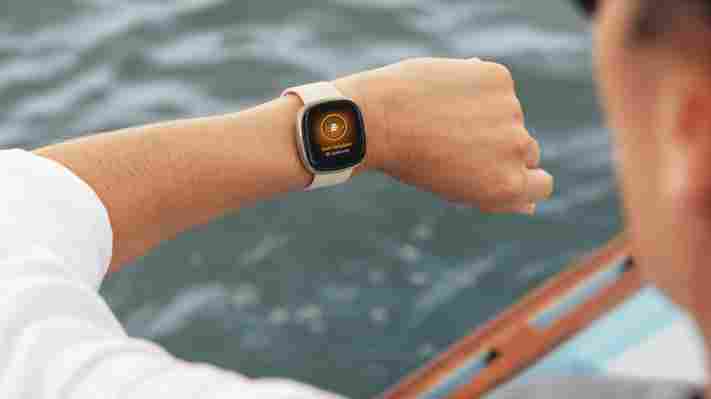We've seen our first hints that the long-awaited Fitbit Sense 2 may be in production, and we'll be gathering all the rumors and news together right here as soon as it emerges.
The original Fitbit Sense was something quite special when it launched back in September 2020, and earned a place high up our ranking of the best Fitbits . While many smartwatches and fitness trackers estimate stress levels by monitoring your heartrate variability, the Sense took a different approach by measuring something called electrodermal activity (or EDA).
This is basically the electroconductivity of your skin, and it's affected by sweat. The more active your adrenal glands, the more sweat you produce, and the more conductive your skin becomes. When you activate the EDA app on the Fitbit Sense and place your palm over the screen, the watch sends a tiny electrical current through your skin, and uses a sensor to detect how the conductivity of your skin changes over the course of a minute. The more changes (or 'EDA responses') are reported, the more stressed you're likely to be.
It was novel tech at the time, but now Fitbit has incorporated it into the smaller, more affordable Fitbit Charge 5 , the upcoming Sense 2 will need to offer something even more impressive.

Cut to the chase
Fitbit Sense 2 news and leaks
In late March 2022, references to three new devices were spotted in the install files for Fitbit's Android app. Two of the new watches have square displays with a resolution of 336 x 336 pixels – the same as the Fitbit Versa 3 and Fitbit Sense - while the third has a rectangular screen with a resolution of 124 × 208 pixels. That's the same as the Fitbit Luxe , but since the Luxe only landed in April 2021, we think it's more likely that the Fitbit Inspire is getting a screen upgrade.
The Fitbit Versa 3, Fitbit Sense, and Fitbit Inspire 2 launched simultaneously back in 2020, so it would make sense for their successors to land at the same time too. The two square watches are codenamed 'Rhea' and 'Hera', which are believed to be Star Wars references (in line with Fitbit's previous sci-fi heavy naming conventions), while the rectangular device is 'Nyota'.

What we want to see
There's no other information available at the moment, but we suspect that the Fitbit Sense 2 may have an exciting new feature in the form of all-day EDA monitoring, which tests for EDA responses without you activating the app manually, and alerts you if stress levels appear too high.
It recently came to light that Google (Fitbit's parent company) has submitted an application to the US Food and Drug Administration (FDA) for an algorithm that will allow its watches to monitor for signs of atrial fibrillation passively throughout the day. If the watch detects an irregular heartbeat, it will verify the reading with further checks, then give you an alert on the watch face if it's consistently concerning.
EDA monitoring could be done in exactly the same way, and Google might not need FDA approval for it – which would explain why we've not seen a similar application for this technology.
This could be the winning feature that gives the Fitbit Sense 2 the edge, and could prompt us to choose it over the recently released Fitbit Charge 5, which features EDA detection but requires the wearer to initiate it manually and spend a full minute with their palm over the watch face.
We'll be keeping an ear to the ground for further news and potential leaks surrounding the Fitbit Sense 2, and will keep this article updated as soon as more hints emerge.
Among Us VR is coming to the Oculus Quest 2 before the end of 2022
Get your best Crewmate impressions ready as Among Us VR is headed to the Oculus Quest 2 (now Meta Quest 2) in 'Holiday 2022'; that'll be around November or December most likely.
As part of the 2022 Meta Quest Gaming showcase , we finally got another look at Among Us VR , a version of the hit social deduction that's exclusive to VR headsets .
The new trailer showed us footage of some very energetic meetings, followed by a rough tour of the Skeld Map - a tour that abruptly ends when a dead crewmate is found. We didn’t get a look at tasks or if crewmate roles are coming to Among Us VR, but it is confirmed that we can mash a big red emergency meeting button when things get dicey.
Pus, developers InnerSloth, Schell Games, and Robot Teddy confirmed that it will be coming to the Quest 2 by the end of the year.
We’re sure most of you wanted a more exact release date, but before you throw someone out of the airlock in a fit of rage, there’s some good news that might cheer you up.
During the showcase it was also announced that Schell Games is developing three new VR games in partnership with Meta - but what could they be?
Analysis: What could be Schell Games’ next titles?
Schell Games has produced some incredible and varied hits for the Oculus Quest 2. There’s the spy-themed escape room series I Expect You To Die (and its sequel), the hack’n’slash rouguelite Until You Fall, and the educational cooking sim Lost Recipes .
As such, Schell Games’ next three games after Among Us VR could be literally anything. That said, we think at least one (but likely two) will be follow-ups to its preexisting games.
The I Expect You To Die series offers some hilarious James Bond-esque puzzles for you to solve. Given that both games so far have been beloved by players and critics alike a third installment feels like a shoo-in.

An Until You Fall 2 also feels pretty likely. The dual sword dueling mechanics of the first game are already excellent so with a slight tune-up, plus an expanded scope, we imagine an Until You Fall 2 would sell gangbusters on the Quest 2.
These two games are also frequently lauded by Meta as some of the best its platform has to offer. It would make a lot of sense for the company to request follow-ups to these titles as part of a collaboration with Schell Games.
Then for the third title, we wouldn’t be surprised if Schell Games brought out another educational game or one aimed at a younger audience. In our chat with Lost Recipes’ Creative Director, Melanie Harke , she explained that’s where a lot of her passions lie - and Schell has a history of making this style of VR games.
Given that Meta recently introduced parental controls to its platform, it wouldn’t be a surprise if it started gearing its Quest headsets towards a younger generation.
There are some issues with its plans - for one its headsets just aren’t designed for smaller heads and might be too heavy for some - but if it can solve these with its Quest 3 or Cambria headsets, or through some kind of add-on then it’ll want a library of hits to capitalize on it new market.
Who better to help create one of these family-friendly games than one of the best VR game developers out there?
We'll have to wait and see what Schell Games announces next, but we can't wait
10 albums you need to hear in Apple Music’s Spatial Audio
Spatial Audio is one of Apple Music’s key listening features. It simulates audio coming from different directions, just like Dolby Atmos. The feature can even track your head movements so that the sound moves with you. Cool, right?
It was first rolled out as a feature for videos on Apple devices, and was brought to Apple Music in 2021. With Spatial Audio enabled, you can listen to your favorite albums in a more immersive format, making it feel as though the elements of a piece of music are coming at you from every angle.
Using the feature requires a pair of AirPods Pro , AirPods Max , AirPods (3rd generation) , or Beats Fit Pro , and a newer iPad, iPhone, or Mac. Interestingly, some MacBooks, iPhones, and iPads support the feature through their built-in speakers, and so does the new Studio Display . You can find a full list of supported devices on Apple’s support pages .
That’s all well and good, but what can you actually listen to in Spatial Audio (aside from The Beatles' Abbey Road album, of course)? With some albums specifically mastered for the feature, and wide option of playlists to peruse on Apple’s streaming platform, here are ten albums that we think you need to hear in Apple Music’s Spatial Audio to get you started.
1. Sour - Olivia Rodrigo

Sour is the first studio album from Olivia Rodrigo. Perhaps best known for her Disney roles, Rodrigo sprung to international pop stardom in 2021. The young artist has already achieved awards for the most streams of her album, and it’s not even been out for a year. This album was specifically mixed for Spatial Audio, and Apple has used the album in most of its marketing for the feature (recognize the purple album cover?). And you can tell, because this album exemplifies all the benefits of the technology. When listening to the tracks, your ears truly do get enveloped in the sound, and some of the acoustic songs make it feel as though you’re right there in the room with Rodrigo. The bass is clear and punchy, while her soft and mellow vocals flow through the soundstage with excellent presence and clarity.
Listen out for non-musical sounds like footsteps in the tracks 1 step forward, 3 steps back and enough for you; these should have a clear sense of direction within the wider mix. Guitar melodies also stand out in this album, being particularly highlighted below Rodrigo’s voice in the mix.
2. WHEN WE ALL FALL ASLEEP, WHERE DO WE GO?- Billie Eilish

WHEN WE ALL FALL ASLEEP, WHERE DO WE GO? is Billie Eilish’s debut studio album (we promise they’re not all like this). Having gone from producing her first album in a bedroom studio to gaining international acclaim as the most recent James Bond theme artist, the album that started it all remains one of Eilish’s most popular. Eilish is well-known for her soft, raspy vocals, and Spatial Audio makes it sound as though she’s whispering straight into your ear. This contrasts with the signature pounding bass that punctuate most of the tracks in this album, and creates a sense of texture within the 3D soundscape. Where Spatial Audio really enhances this album is in the panning. Notably the start of bad guy and throughout my strange addiction, the traditional technique of switching audio between the left and right channels is amplified to the point where the music really does sound like it’s convincingly coming at you from either side of your head.
3. 1 - The Beatles

1 is one of The Beatles’ most recognizable compilation albums. Home to some of the band’s most beloved tracks, this 2015 remaster includes dedicated stereo mixes, and has been recently adapted for Spatial Audio . Spatial Audio on this album is perfect for helping you pick out the different layers in the soundstage, rather than pinpointing individual instruments. You can hear the voices, percussion, and strings all stacked on top of one another like your ears are biting into a well-made sandwich. Tracks like Eleanor Rigby with distinct and slashing strings take full advantage of the sonic space afforded by Spatial Audio. Listening to this album is just like you’re in the room with John, Paul, Ringo, and George.
4. Rumours - Fleetwood Mac
Rumours is definitely a bit of a throwback. The album dominated the radio waves back in the 70s when it was released, and it’s a beloved album today still. Spatial Audio simply takes this classic album and gives you a new way to experience it.
As we listened to the tracks with Spatial Audio, the bass sounded excellent, with lots of space for those lower frequencies to resonate without muddying the rest of the soundstage. You should be able to clearly identify instruments and sound effects as they move around your head, especially with the trailing vocal in Dreams.
Listen out for the drums in many of the tracks, which have a notable direction behind the vocals, just as they would be in-person. With this album it’s like you’re in the recording booth with Fleetwood Mac, never mind just being in the room.
5. The Dream - alt J
The Dream contains some of alt-J’s most popular tracks; and now that it supports Spatial Audio, fans of the alternative trio are in for a treat. On most tracks, you’ll feel as though the sound completely envelopes you. You can pin this down to distinct sounds like a cymbal and snare, and the deep bassy beats moving through the mix. Again, the elements of each track are perfectly placed to create layers, giving the effect that the music is totally surrounding you - it’s a less naturalistic sound than the Spatial Audio mix for Rumors, but it’s more immersive.
6. The Immersive Experience- London Philharmonic Orchestra, Ben Gernon
The Immersive Experience is an album picking out some of the London Philharmonic Orchestra’s most popular renditions - you’ve got everything from Debussy to Berlioz - and optimizing them for Spatial Audio. It’s a must-listen for classical music fans that want to replicate the sound of a concert hall without leaving their living room.
The Dolby Atmos mix means you can clearly pick out individual sections of the orchestra, with each instrument given the space it needs to shine - even in complex arrangements. Not only can you identify these sections, they’ve also got a clear direction. Listen there, the strings section is in the front-left!
This virtual surround sound effect emulates a concert hall pretty realistically, so you can get a taste of what it’s like to see the orchestra perform in real life.
7. Starboy - The Weeknd
2016’s Starboy is one of The Weeknd’s most popular albums. It’s back before Blinding Lights’ TikTok popularity and the Superbowl 2021 Halftime Show . Listening to this album, you can once again pick out individual sounds more clearly than you can in stereo (it’s almost like Spatial Audio is made for this), with the piano in the album’s title track coming through with particular detail. In other tracks, listen out for more mellow beats in particular, which seem to have an undiscovered depth to them. Vocals have a strong sense of directionality too, which makes for a truly immersive experience.
8. A Night at the Opera - Queen
A Night at the Opera is Queen’s fourth studio album. It contains some of the band’s biggest songs, and also some you may not have heard before. It’s not just an album, it’s an experience. This album also excels in the panning between the left and right sides of your head. In Bohemian Rhapsody, there’s a real sense of the free flowing structure as the instrumental section of the track not only bounces between your ears, but around the simulated soundscape. The whining strings from the guitar and violin particularly shine here, in a kind of coordinated chaos. These are accompanied by the deep crashing bass, which seem to come from above (just like thunder and lightning). It’s a really different way of hearing the album. In the tracks with complex vocal harmonies, Spatial Audio makes it really easy to pick these out and give them a direction; almost like you can tell who was standing where. Listening to this album, it’s like you’re inside each of the tracks.
9. The Blues And The Abstract Truth - Oliver Nelson
The Blues And The Abstract Truth is a jazz album you may not have listened to before, but Oliver Nelson was an incredible artist, and this album showcases his talent. Ted Lasso fans might recognize a track or two from some of the show’s episodes. Listening to the album, you can clearly identify each of the instruments being played. Not only this, but Spatial Audio helps highlight the leading instrument by making it sound closer, before the next instrument takes over. It’s a great way to bring out the conversational (and sometimes conflicting) interactions between the different instruments. Keep an ear out in the (virtual) distance for some of the softer drum beats, which increase in volume as the conversation becomes more heated.
10. Sometimes I Might Be Introvert - Little Simz
Sometimes I Might Be Introvert is British rapper Little Simz’ fourth studio album. It’s a fast-paced, soulful work, juxtaposing confessional lyrics and boisterous beats with sweeping orchestral movements and haunting choral harmonies. You can hear the directionality of Simz’ voice as it moves around the virtual environment, accompanied by chopped and screwed 80s beats and flourishing strings. Even in the more crowded arrangements, you can pick out every instrument clearly - and this is only enhanced by the extra space provided by the Spatial Audio mix.